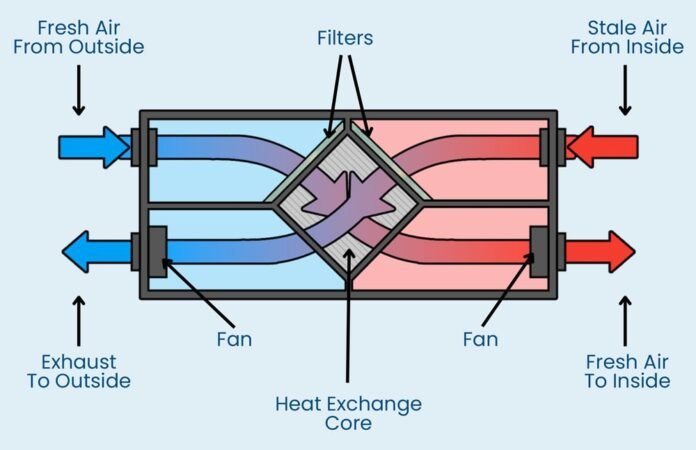Your home might look cozy from the outside, but there’s a good chance it’s secretly wasting energy every single day. While you’re busy worrying about turning off lights and unplugging chargers, your house could be hemorrhaging heated air through poor ventilation. The solution? An MVHR unit that most homeowners have never even heard of.
If you’re tired of sky-high energy bills and stuffy indoor air, it’s time to discover why mechanical ventilation with heat recovery systems are becoming the gold standard for energy-efficient homes. Let’s explore how this technology works and why it might be the smartest upgrade you’ll ever make.
What Exactly Is an MVHR Unit?
MVHR stands for Mechanical Ventilation with Heat Recovery. Think of it as your home’s respiratory system with a built-in energy saver.
Here’s the basic concept: instead of just opening windows to let fresh air in (and losing all your expensive heated air), an MVHR unit captures the heat from outgoing stale air and transfers it to incoming fresh air. It’s like having a conversation between your old air and new air, where the old air whispers, “Hey, take my warmth with you.”
The system works through a network of ducts that extract stale air from wet rooms like kitchens and bathrooms, while simultaneously supplying fresh, filtered air to living spaces and bedrooms. The magic happens in the heat exchanger, where the two airstreams pass each other without mixing.
The Energy Efficiency Game-Changer
Let’s talk numbers for a moment. A quality MVHR unit can recover up to 95% of the heat that would otherwise escape through traditional ventilation methods.
That’s not just impressive—it’s money back in your pocket.
Traditional ventilation methods are basically throwing money out the window. Literally. When you open a window on a cold day, you’re not just letting in fresh air—you’re sending your expensive heated air on a one-way trip to the great outdoors. Your heating system then has to work overtime to bring the temperature back up.
An MVHR unit breaks this wasteful cycle. The system ensures continuous fresh air circulation while keeping your heating costs manageable. During winter months, this can translate to significant savings on your energy bills.
Indoor Air Quality That Actually Matters
Energy efficiency is great, but let’s be honest—what good is saving money if you’re breathing stale, polluted air?
Modern homes are built to be airtight for energy efficiency, but this creates a new problem: trapped pollutants, excess moisture, and stagnant air. Without proper ventilation, your home becomes a sealed container of cooking odors, bathroom humidity, and whatever chemicals are off-gassing from your furniture and cleaning products.
An MVHR unit addresses these issues by:
- Continuously removing stale air from your home
- Filtering incoming fresh air to remove pollen, dust, and other pollutants
- Controlling humidity levels to prevent mold and condensation
- Eliminating drafts that come with opening windows for ventilation
The result? Air that’s actually fresh, not just moved around by a fan.
Health Benefits You Can Feel
Better air quality isn’t just about comfort—it’s about your health and well-being.
Poor indoor air quality can trigger asthma, allergies, and respiratory issues. Excess humidity leads to mold growth, which can cause serious health problems. Conversely, air that’s too dry can irritate your respiratory system and skin.
Many homeowners report sleeping better after installing an MVHR unit. The constant supply of fresh, filtered air and optimal humidity levels create ideal conditions for rest. No more waking up to stuffy bedrooms or dealing with condensation on windows.
Installation and Maintenance Reality Check
Let’s address the elephant in the room: yes, installing an MVHR unit requires some planning and investment.
The system works best when integrated during construction or major renovations, as it requires ductwork throughout your home. However, retrofit installations are possible, though they may be more complex and expensive.
Maintenance is surprisingly straightforward:
- Filter replacement – Usually every 6-12 months
- Duct cleaning – Every few years depending on usage
- Annual system check – To ensure optimal performance
The maintenance requirements are minimal compared to the benefits you’ll receive. Most homeowners find the routine upkeep less demanding than maintaining a traditional HVAC system.
Environmental Impact That Counts
Beyond personal benefits, MVHR units contribute to broader environmental goals.
Reduced energy consumption means lower carbon emissions. When your home requires less heating and cooling, you’re directly reducing your environmental footprint. This technology aligns with green building standards and can contribute to home certification programs.
For environmentally conscious homeowners, an MVHR unit represents a practical way to reduce their impact without sacrificing comfort or convenience.
Making the Investment Decision
The upfront cost of an MVHR unit might seem substantial, but consider the long-term picture.
Energy savings accumulate month after month, year after year. Improved indoor air quality can reduce healthcare costs related to respiratory issues. The system can also increase your home’s value, especially as energy efficiency becomes increasingly important to buyers.
Many homeowners find that the combination of energy savings, health benefits, and increased property value makes the investment worthwhile.
Your Next Steps Toward Better Indoor Air
An MVHR unit isn’t just another home gadget—it’s a fundamental upgrade to how your home manages air and energy. The technology addresses multiple issues simultaneously: high energy bills, poor air quality, and environmental impact.
If you’re considering energy efficiency upgrades, don’t overlook the potential of mechanical ventilation with heat recovery. Research local contractors who specialize in MVHR installations, and get quotes for your specific situation.
Your lungs, your wallet, and your planet will appreciate the investment in cleaner, more efficient home ventilation.
